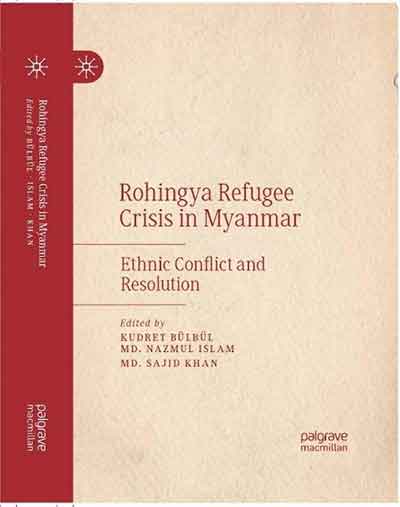Book Review: ROHINGYA REFUGEE CRISIS IN MYANMAR: ETHNIC CONFLICT AND RESOLUTION (Palgrave Macmillan)
Edited by: Kudret Bülbül, Md. Nazmul Islam & Md. Sajid Khan
 Considering the current situation of crisis, the publication of the Rohingya Refugee Crisis in Myanmar: Ethnic Conflict and Resolution is very timely and something that was required. The editors of the book, Kudret Bülbül, Md. Nazmul Islam and Md. Sajid Khan made it a comprehensive collection, talking about the selection and arrangements of chapters covering the different aspects of the Rohingya refugee crisis. This edited book combines some recent, authentic, and very good quality research on the Rohingya refugee crisis contributed by the scholars of different specializations, like international relations, political science, public administration, human rights, mass communication, journalism, migration studies, and other. The book is a much-needed addition to the existing literature on Myanmar’s Rohingya crisis. It allows the readers to understand what is going on in the country today as well as the historical grounds of atrocities in the region. While it addresses the present situation of the crisis and seeks for the resolution in the light of the present global scenario, it also presents a historical insight on –Myanmar’s socioeconomic and political structure, its politics, policies, relationship with neighbors, and also the position of Rohingyas in Myanmar. The major purpose of the book is to attract attention to the Rohingya situation. This book points out the immediate need of the world community to take action for resolving the issue. This book covers the struggles of Rohingyas for their existence, health, environmental impacts in Bangladesh, issues in India, threats in Myanmar, and various other issues in the West. The role of China, India, other big international actors have been described to understand the policy challenges and current situations in resolving the Rohingya crisis.
Considering the current situation of crisis, the publication of the Rohingya Refugee Crisis in Myanmar: Ethnic Conflict and Resolution is very timely and something that was required. The editors of the book, Kudret Bülbül, Md. Nazmul Islam and Md. Sajid Khan made it a comprehensive collection, talking about the selection and arrangements of chapters covering the different aspects of the Rohingya refugee crisis. This edited book combines some recent, authentic, and very good quality research on the Rohingya refugee crisis contributed by the scholars of different specializations, like international relations, political science, public administration, human rights, mass communication, journalism, migration studies, and other. The book is a much-needed addition to the existing literature on Myanmar’s Rohingya crisis. It allows the readers to understand what is going on in the country today as well as the historical grounds of atrocities in the region. While it addresses the present situation of the crisis and seeks for the resolution in the light of the present global scenario, it also presents a historical insight on –Myanmar’s socioeconomic and political structure, its politics, policies, relationship with neighbors, and also the position of Rohingyas in Myanmar. The major purpose of the book is to attract attention to the Rohingya situation. This book points out the immediate need of the world community to take action for resolving the issue. This book covers the struggles of Rohingyas for their existence, health, environmental impacts in Bangladesh, issues in India, threats in Myanmar, and various other issues in the West. The role of China, India, other big international actors have been described to understand the policy challenges and current situations in resolving the Rohingya crisis.
This book covers the events of the recent coup d’état in 2021, in which the junta took control over the country and detained its democratic leaders. Covering the different aspects of the coup and the possible consequences on the Rohingya refugees living in Bangladesh makes it more updated and relevant literature in this series. It addresses the political reactions to the Rohingya refugee crisis at the global as well as regional levels. In this regard, special attention has been paid to the politics of South-East Asia, particularly of China, Bangladesh, and India.
Inside the book
This edited book focuses on the Rohingya refugee crisis beyond history and politics within the sixteen chapters’ framework. This book is based on primary and secondary research, largely drawn from literature, descriptive, fact-finding, and fieldwork data. Nevertheless, this book contends 16 chapters under two specific thematic areas such as policy and politics of the Rohingya Crisis beyond the Refugees, Rohingya ethnic conflict and resolution. Still, in the analytical section, the book emerged as several thematic, theoretical, and experimental discussions.
The book’s opening chapter deals with the advent of Islam in the Arakan and its internal diffusion process. It shed light on some important Muslim development in the region, including the Arakanese kingdom, founded in B.C. 2666. Then it analyzes whether the acts of the Myanmar government and their security forces against Rohingya people held them accountable for violating international law on the grounds of genocide, forced migration, and forced labor. It presents an analytical discussion consisting of the previous decisions of ICTY, ICTR, ICC, and ICJ. Next, it focuses on the problem of the human trafficking of refugees. The major policies and politics in Myanmar towards the Rohingya minority during 2008 to 2020 have been discussed in a chapter by using a constructivist approach followed by qualitative methodology and connecting analysis of textual data.
Issue linked with the interests of the political parties, particularly parties in the power of Bangladesh, in hosting or not hosting Rohingya in the fifth chapter. The book also sees the Rohingya Muslim refugee crisis from the perspective of Bangladesh and Myanmar foreign policy, where instrumentalism and primordialism theories have been employed to identify the Rohingya ethnic minority crisis in Myanmar. It outlines Myanmar’s steps to resolve the Rohingya catastrophe by analyzing Bangladesh and Myanmar’s foreign policy to address the region’s current humanitarian emergency.
In a chapter, policies and plans of the Indian government and non-government organizations throughout the years have been discussed from various points of view. It unfolds the role of I/NGOs in supporting Rohingya refugees in India and also explores the recent coup and the succeeding challenges for both the Indian government and the Myanmar government in resolving the Rohingya refugee crisis.
An important discussion covering the deriving factors that encouraged China to be a peace settler in the region to find out its important socioeconomic and political interests linked with the crisis has been mentioned in the book. It argues that rather than to resolve the Rohingya crisis, China’s motive is to attain such interests. This book has also mentioned an important and most of the time ignored aspect linked with this hate crime that is the role of mass media in representing the issue in public. One chapter tries to find an in-depth analysis of the Rohingya refugees’ representation in the top five Bangladeshi media (both Bengali and English), which is conducted using the content analysis method in the context of the historical relationship between Myanmar and Bangladesh. Similarly, the book also includes the reporting of the Rohingya issue in Indian mass media in a study based on the thematic analysis of two major Indian news media.
The role and the extent of the commitment of the international community and, in particular, western countries in responding to the situation has been analyzed in the book. It poses some important questions and seeks to answer them, like Are the efforts and commitment to end the brutality against the Rohingyas enough? What actions are being taken so far and are there gaps that can be filled to achieve a quicker and more sustainable resolution to the problem?
In concluding chapter, it evaluates the Stories from the Spectacle of Rohingya. This chapter employed thematic analysis based, which aimed to find out the Rohingya’s current problems, regional and international responses with the short, long term solutions of Rohingya ethnic conflict and resolution, where editors identified the future of Rohingya people and Rohingya refugees around the world. Editors used the semi-structured interview to get reliable data, where Rohingya leaders and activists were taken as a purposive sample for proceeding with this study.
This book examines the Rohingyas’ historical, political, ethnic, and policy challenges from South Asia to Southeast Asia, as well as regional and international politics. Concerning the contemporary situation of the Rohingya, this edited book is appropriate for historians, political scientists, sociologists, anthropologists, and more general readers, policymakers, academics, and journalists.
Faisal Mahmood is a research scholar in human rights, currently working on the area of internal displacement
















































